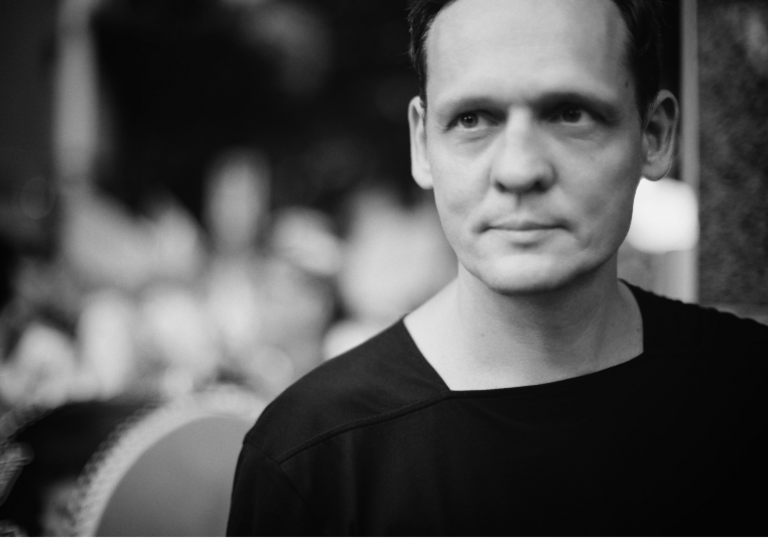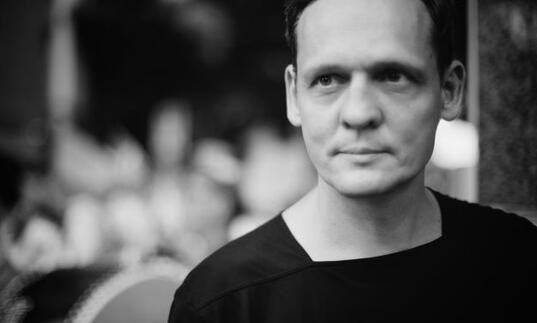Alva Noto + s t a r g a z e: Xerrox Selected - digital programme

Electronic musician Alva Noto’s ‘Xerrox’ series is as expansive as the music itself. He tells James Drury he never intended the project to be so long-lasting, but that it’s transformed his practice.
At what point does a copy of an original cease to become a copy and becomes an original itself? That philosophical question lies at the heart of Alva Noto’s incredible ‘Xerrox’ project, which spans four albums, with a fifth and final instalment on the way.
Each album in the series starts with a collection of samples, which the German electronic music pioneer (real name Carsten Nicolai) manipulates and copies over and over until they become unrecognisable from the starting point. He then uses these ‘new’ works to create the sound worlds that are the signature of the series. Minimalist, yet at the same time expansive, each record is an evolution from the previous one. Listening to them in chronological order is like a journey that becomes ever more capacious and galaxy-spanning as you progress. He loosely refers to them as ‘concept albums’ in the same lineage as those he grew up with in the 70s and 80s, such as early Genesis and Brian Eno.
Nicolai was first inspired to explore this idea while travelling in Japan in the mid-2000s. ‘I was living in a hotel for a week, and background music was always playing – what we would call musak – music for hotels in the best sense of Brian Eno. I bought a small handheld recording device and recorded it. But as I opened the files, my computer couldn’t handle the high resolution and opened them in a completely different format. It meant they’d all been corrupted and sounded completely different – they’d been slowed down and had interpolations. At this moment, I recognised there’s great artistic potential in transferring from one file format to another. It got me thinking about the digital copying mechanism as a quality I could work with.
‘I wanted to work with this idea of the imperfections that creep into copies,’ he recalls. ‘So, I took the sample and copied it, then made a copy of the copy and a copy of that, and so on. I decided to write five albums, expecting to produce one a year. But the process of making these copies took so long that it’s been 16 years (‘Xerrox Vol 1’ was released in 2007) and I haven’t finished ‘Xerrox Vol 5’, which I’m writing now.’
The series was named after the brand of document copying machines, but with a twist that reflects the premise: the double r of the ‘misspelling’ incorporates the idea of ‘error’ and the imperfections that creep into copies of original works. Nicolai has previously written that the images that come to mind when we’re asked to think of iconic buildings or paintings are copies. Most people have never seen the original, only photos online or in books.
The tale of bringing tonight’s concert to life is almost as long as the Xerrox project itself. It wasn’t long after Nicolai released ‘Xerrox Vol 1’ in 2007 that leader of orchestral collective s t a r g a z e, André de Ridder got in touch. The conductor had been so inspired by the work that he wanted to transcribe it and perform it with the orchestra.
But Nicolai had his doubts. He wasn’t sure how his computer-generated sounds would translate into the acoustic world of the orchestra. The idea got parked.
However, as the years rolled by, Nicolai’s composition style evolved. ‘The later records sound a bit like a soundtrack,’ he says. ‘But they don’t have a movie to go with them. In a way, I composed for an imaginary film. I used a lot of aesthetics you would normally associate with classical music than electronic music, and there’s no beat.’
Perhaps this shift softened his thoughts about the potential for ‘Xerrox’ to be performed by orchestra. Then, in 2021, along came a collaboration with Ensemble Modern and arranger Max Knoth to orchestrate ‘Xerrox Vol 4’. This convinced Nicolai that the idea would work. ‘It was a very surprising and positive moment for me because I’d never thought about the advantages of performing it with classical musicians,’ he says. ‘But what I found really interesting and very beautiful is that once I heard it, I was struck by the fact that it had a quality I’d not thought of, and I realised these pieces could be played by classical musicians, even if the sonic quality of the electronics is not that strong anymore.
‘I think that because I don’t read music, I’d never considered that they could be performed this way, but others saw the potential in them.’ And so, he was ready to work with de Ridder to bring an instrumental version of the series to the stage, arranged especially for s t a r g a z e.
‘What struck me listening to the early ‘Xerrox’ records is there’s a lot of intricate classical strings sounds, but Carsten uses samples and synth pads,’ de Ridder says. ‘Then there’s this amazing, wonderful contrast with noise elements that struggle with these classical, cinematic soundscapes. What’s always interested us in s t a r g a z e is combining these different elements and performing collaboratively with musicians that use electronic treatments.’
Nicolai has a longstanding association with the pan-European orchestra, which specialises in marrying modern composition with alternative attitudes and sounds. Probably most famously, they performed on the soundtrack to the film The Revenant, which was written by Nicolai and Japanese composer Ryuichi Sakamoto; the pair worked together on numerous projects, not least ‘Xerrox Vol 2’, for which Sakamoto provided original samples for Nicolai to manipulate.
Working up these arrangements of Xerrox has been fascinating for all involved, says de Ridder. ‘This has been an interesting look at how we create this electronic music acoustically. While we strive to make it as accurate as possible, it still brings a different aesthetic. For example, we discussed at great length whether we should use a click track to time everything very precisely, but we decided not to because that would take away all the freedom that happens when you perform live. It's going to be a little scary, but I also love the idea that we will be able to create the works in a live setting, with all the uncertainties and atmosphere that brings.’
To ensure the performance of eleven tracks from across the series retains a connection to the electronic sounds of the original works, Nicolai will join the orchestra as a performer. And – this being an Alva Noto show – it will, of course, feature visuals too.
What all this further alteration of the original samples means for the question of when a copy becomes a new work in its own right is something you’ll have to ponder as you experience tonight’s concert.

